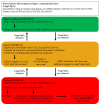Management of COVID-19-Associated Acute Respiratory Failure with Alternatives to Invasive Mechanical Ventilation: High-Flow Oxygen, Continuous Positive Airway Pressure, and Noninvasive Ventilation
- PMID: 34943496
- PMCID: PMC8700515
- DOI: 10.3390/diagnostics11122259
Management of COVID-19-Associated Acute Respiratory Failure with Alternatives to Invasive Mechanical Ventilation: High-Flow Oxygen, Continuous Positive Airway Pressure, and Noninvasive Ventilation
Abstract
Patients admitted to hospital with coronavirus disease 2019 (COVID-19) may develop acute respiratory failure (ARF) with compromised gas exchange. These patients require oxygen and possibly ventilatory support, which can be delivered via different devices. Initially, oxygen therapy will often be administered through a conventional binasal oxygen catheter or air-entrainment mask. However, when higher rates of oxygen flow are needed, patients are often stepped up to high-flow nasal cannula oxygen therapy (HFNC), continuous positive airway pressure (CPAP), bilevel positive airway pressure (BiPAP), or invasive mechanical ventilation (IMV). BiPAP, CPAP, and HFNC may be beneficial alternatives to IMV for COVID-19-associated ARF. Current evidence suggests that when nasal catheter oxygen therapy is insufficient for adequate oxygenation of patients with COVID-19-associated ARF, CPAP should be provided for prolonged periods. Subsequent escalation to IMV may be implemented if necessary.
Keywords: BiPAP; COVID-19; CPAP; HFNC; NIV; acute respiratory failure; bilevel positive airway pressure; continuous positive airway pressure; high-flow nasal cannula oxygen therapy; noninvasive ventilation.
Conflict of interest statement
All authors have completed the ICMJE uniform disclosure form, describing any conflicts of interest. None of the authors have any conflicts of interest that are directly related to this work.
Figures

References
-
- Agarwal S.K., Heiss G., Barr R.G., Chang P.P., Loehr L.R., Chambless L.E., Shahar E., Kitzman D.W., Rosamond W.D. Airflow obstruction, lung function, and risk of incident heart failure: The Atherosclerosis Risk in Communities (ARIC) study. Eur. J. Heart Fail. 2012;14:414–422. doi: 10.1093/eurjhf/hfs016. - DOI - PMC - PubMed
-
- Chalmers J.D., Crichton M.L., Goeminne P.C., Cao B., Humbert M., Shteinberg M., Antoniou K.M., Ulrik C.S., Parks H., Wang C., et al. Management of hospitalised adults with coronavirus disease 2019 (COVID-19): A European Respiratory Society living guideline. Eur. Respir. J. 2021;57:2100048. doi: 10.1183/13993003.00048-2021. - DOI - PMC - PubMed
-
- Parrillo J.D.R. Critical Care Medicine. 3rd ed. Mosby Elsevier; Maryland, MO, USA: 2007.
Publication types
Grants and funding
LinkOut - more resources
Full Text Sources

